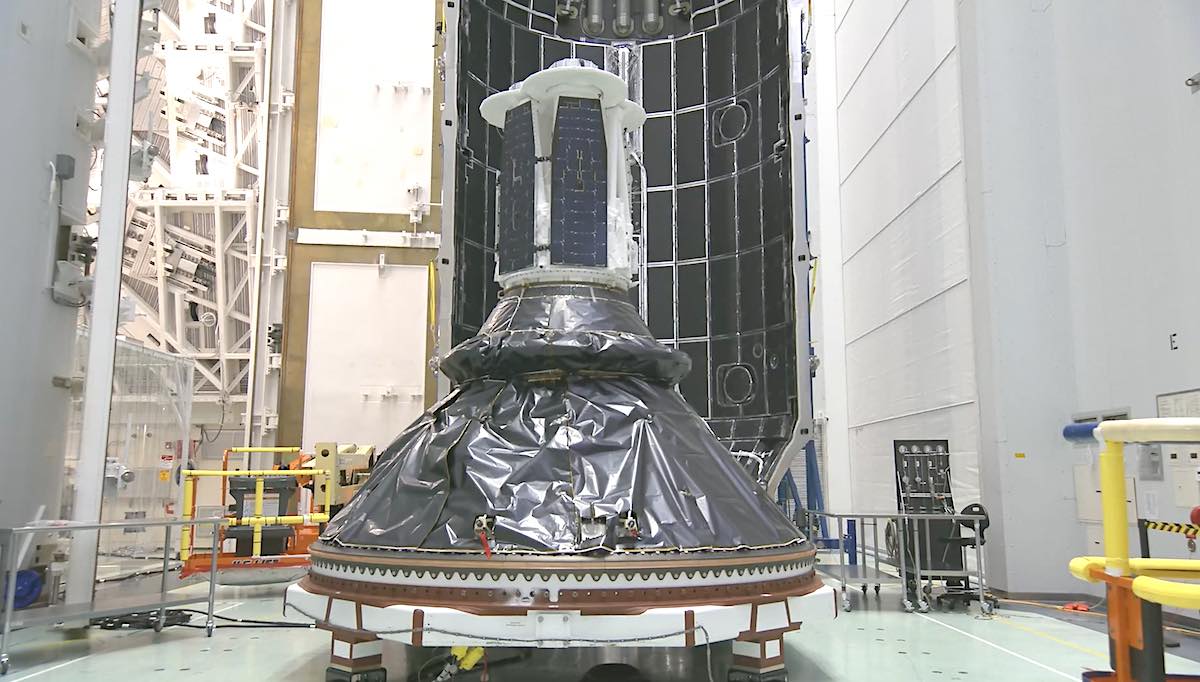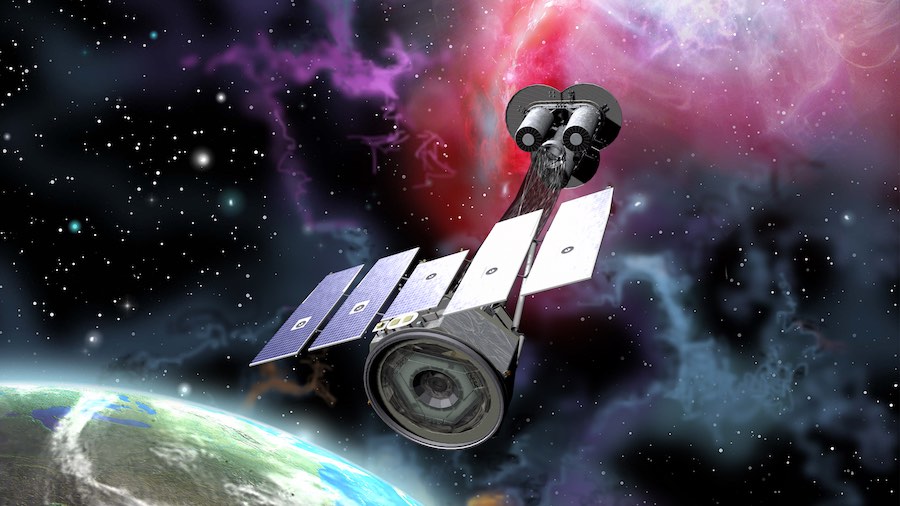
A NASA astronomy satellite will be the smallest payload to ever get a dedicated ride on a Falcon 9 rocket when it takes off from Florida this week, but the SpaceX launcher will need to flex its muscles to reach the mission’s unusual orbit hugging the equator.
The astronomy observatory is about the size of a refrigerator in its launch configuration, and liftoff from launch pad 39A is set for a 90-minute window opening at 1 a.m. EST (0600 GMT) Thursday.
Satellites booked for dedicated launches on SpaceX’s Falcon 9 rocket can weigh many tons, but NASA’s Imaging X-ray Polarimetry Explorer weighs just 727 pounds (330 kilograms) and fills a small fraction of the launcher’s voluminous payload shroud.
The mission is heading to an orbit 373 miles (600 kilometers) above Earth. But instead of flying on a straight shot east or northeast from Cape Canaveral, as most SpaceX missions do, the Falcon 9 rocket will make a hard left turn when it crosses the equator less than a half-hour after liftoff.
The Falcon 9’s second stage engine will fire with the rocket flying sideways, maneuvering the IXPE spacecraft into an orbit deviating just 0.2 degrees in latitude on each side of the equator.
The maneuver to change the plane of the satellites orbit, colloquially called a “dogleg,” will consume much of the Falcon 9’s performance capability. A Falcon 9 launching to a similar altitude without the plane change maneuver could loft a payload of more than 30,000 pounds, or 14 metric tons.
Taking into account the plane change, and reserving enough propellant to return the reusable Falcon 9 booster to an offshore landing, the carrying capacity of SpaceX’s workhorse rocket shrinks to a little more than a ton.
“We launch due east out of the Cape, and then that would put us in a 28-degree inclination orbit,” said Tim Dunn, NASA’s launch director of the IXPE mission, in an interview with Spaceflight Now. “When we hit the equator just off the coast of Africa … we do a pretty significant dogleg to take that 28 degrees out. That’s a significant plane change. But fortunately, we’re looking at about a 330-kilogram spacecraft mass, and we do have a lot of performance on the Falcon 9 rocket.
“We have significant margin, but given the mass that we’re launching, and we all know the Falcon 9 is a very high-performing vehicle, it does take a lot of its performance to zero out that 28-degree inclination.”

The Falcon 9’s second stage will deploy the IXPE spacecraft into orbit around 33 minutes into the mission, then will reignite its Merlin engine for a deorbit burn to re-enter the atmosphere and burn up over the Pacific Ocean.
Ground crews at NASA’s Kennedy Space Center attached the IXPE spacecraft to the Falcon 9 rocket Sunday night, Dunn said, a day after SpaceX test-fired the booster on launch pad 39A without the payload.
The integration of the spacecraft with its rocket follows several weeks of testing and checkouts at SpaceX’s payload processing facility, where IXPE arrived in November from its factory at Ball Aerospace in Boulder, Colorado.
During the mission’s preliminary design phase, engineers assumed IXPE would launch on Northrop Grumman’s air-dropped Pegasus XL rocket. The IXPE spacecraft was originally designed to fit inside the Pegasus rocket’s payload fairing envelope.
IXPE needs to fly in an unusual equatorial orbit to minimize the X-ray instrument’s exposure to radiation in the South Atlantic Anomaly, the region where the inner Van Allen radiation belt comes closest to Earth’s surface. That will reduce interference that could affect the sensitivity of IXPE to faint astronomical X-ray sources.
“The inclination is very important to us because, in an equatorial orbit, the cosmic wave background is minimum,” said Luca Baldini, the Italian co-investigator for the IXPE mission from the National Institute for Nuclear Physics in Pisa, Italy. “That’s kind of the best orbit that you can possibly shoot for in terms of the background from charged particles.”
Northrop Grumman’s air-launched Pegasus XL rocket could have sent the IXPE spacecraft into an equatorial orbit from a position over the Pacific Ocean near Kwajalein Atoll, the remote tropical staging point for four previous Pegasus missions.
But SpaceX’s much larger Falcon 9 can do the job from Kennedy Space Center, and can do it cheaper. SpaceX won a $50.3 million contract in 2019 to launch IXPE on a reused Falcon 9 booster, while Northrop Grumman charged NASA more than $56 million for a Pegasus launch in 2014.

The IXPE mission is part of NASA’s line of small explorer-class science missions, with cost caps and highly-focused research objectives. IXPE will measure the polarization of X-rays coming from distant cosmic sources, such as black holes, neutron stars, and other objects inside and outside our own Milky Way galaxy.
“IXPE is going to open a new window on the X-ray sky, that of imaging polarimetry,” said Brian Ramsey, the mission’s deputy principal investigator at NASA’s Marshall Space Flight Center in Alabama. “That’s going to give us two completely new measurements that are going to help us understand how some of the most dramatic and energetic events in the universe take place.”
The spacecraft carries three identical X-ray telescopes to focus incoming X-rays onto state-of-the-art detectors supplied by NASA partners in Italy.
“We’re looking at black holes, exploding stars,” Ramsey said. “We’re looking at very intense magnetic fields, a thousand million million times the magnetic field of the Earth. So we’re very excited about this mission. We’re very anxious to get on orbit and start probing the mysteries of these very exotic X-ray sources.”
After separating from the Falcon 9 rocket, IXPE will open its solar arrays and then extend an origami-like boom about a week after launch. The mission’s three X-ray mirror modules are mounted on the tip of the extension, which will give the satellite a length of about 17 feet (5.2 meters) end-to-end.
The mirrors will focus X-ray light back on detectors on the main body of the spacecraft.
IXPE is one of several X-ray astronomy missions in NASA’s portfolio, but it’s the first tuned to measure the polarization signal of X-ray light.
“Photons come with this exotic property that’s called polarization,” Baldini said. “Polarization has to do with the direction of the plane where the electric field of the X-ray oscillates. When an X-ray interacts with our detector, what happens is the photon disappears and then an electron appears in its place. What we’re trying to do is to follow the footsteps of this electron and reconstruct the direction of emission.”
The information will tell astrophysicists about the extreme environments around black holes and supermassive objects, including the supermassive black hole at the center of the Milky Way galaxy.
NASA is funding IXPE for a two-year primary mission. The spacecraft doesn’t need any rocket fuel for pointing or orbital maneuvers.

IXPE’s launch continues a busy stretch of missions for SpaceX and NASA.
The mission will mark the 28th flight of a Falcon 9 rocket in 2021, extending a record for the most Falcon 9 flights in a calendar year. The launch Thursday morning is scheduled less than a week after the most recent Falcon 9 launch from nearby Cape Canaveral Space Force Station carried a new batch of satellites into orbit for SpaceX’s Starlink internet network.
It’s also the fourth launch of a NASA scientific mission since late September.
An Atlas 5 rocket built by SpaceX rival United Launch Alliance launched the Landsat 9 environmental monitoring satellite for NASA and the U.S. Geological Survey on Sept. 27 from Vandenberg Space Force Base, California. Another Atlas 5 launched Oct. 16 from Cape Canaveral with NASA’s Lucy asteroid explorer.
Then SpaceX launched an experimental NASA mission from Vandenberg on Nov. 24 to test out how a spacecraft might be able to divert an asteroid if one is found to be on a collision course with Earth.
NASA’s Launch Services Program at Kennedy, founded in 1998, manages the agency’s procurement and oversight for rocket missions carrying science missions into space. After dozens of flights from military-owned spaceports, the IXPE mission will be the 23-year-old program’s first launch from Kennedy Space Center property.
“We’re all very excited to be launching from Complex 39A,” Dunn said. “Obviously, it is on KSC property, so that’s exciting to be doing that — also just the significant heritage of the missions that have gone before us on 39A. It’s a real honor for LSP to be able to say that we launched a mission from the pad that supported … Saturn 5 missions to the moon, and then obviously the incredible legacy of space shuttle, and the Falcon 9s and Falcon Heavys that have recently come before us.”
NASA officials said the IXPE mission needs to launch from pad 39A, and not from SpaceX’s nearby facility on pad 40 at Cape Canaveral, because the water suppression system at 39A is better capable of protecting IXPE’s scientific payload from the acoustic energy and vibrations at liftoff.
“The water suppression system, the way it is designed at 39A, matches up almost perfect with what was needed for IXPE,” Dunn said.
Email the author.
Follow Stephen Clark on Twitter: @StephenClark1.
from Spaceflight Now https://ift.tt/3rI2esr
via World Space Info







0 comments:
Post a Comment